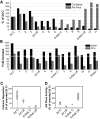Impact of interactions of cellular components of the bone marrow microenvironment on hematopoietic stem and progenitor cell function
- PMID: 20154218
- PMCID: PMC2858485
- DOI: 10.1182/blood-2009-09-246173
Impact of interactions of cellular components of the bone marrow microenvironment on hematopoietic stem and progenitor cell function
Abstract
Hematopoietic stem (HSC) and progenitor (HPC) cell fate is governed by intrinsic and extrinsic parameters. We examined the impact of hematopoietic niche elements on HSC and HPC function by analyzing the combined effect of osteoblasts (OBs) and stromal cells (SCs) on Lineage(-)Sca-1(+)CD117(+) (LSK) cells. CFU expansion and marrow repopulating potential of cultured Lineage(-)Sca-1(+)CD117(+) cells were significantly higher in OB compared with SC cultures, thus corroborating the importance of OBs in the competence of the hematopoietic niche. OB-mediated enhancement of HSC and HPC function was reduced in cocultures of OBs and SCs, suggesting that SCs suppressed the OB-mediated hematopoiesis-enhancing activity. Although the suppressive effect of SC was mediated by adipocytes, probably through up-regulation of neuropilin-1, the OB-mediated enhanced hematopoiesis function was elaborated through Notch signaling. Expression of Notch 2, Jagged 1 and 2, Delta 1 and 4, Hes 1 and 5, and Deltex was increased in OB cultures and suppressed in SC and OB/SC cultures. Phenotypic fractionation of OBs did not segregate the hematopoiesis-enhancing activity but demonstrated that this function is common to OBs from different anatomic sites. These data illustrate that OBs promote in vitro maintenance of hematopoietic functions, including repopulating potential by up-regulating Notch-mediated signaling between HSCs and OBs.
Figures







Similar articles
-
Impact of maturational status on the ability of osteoblasts to enhance the hematopoietic function of stem and progenitor cells.J Bone Miner Res. 2011 May;26(5):1111-21. doi: 10.1002/jbmr.302. J Bone Miner Res. 2011. PMID: 21542011 Free PMC article.
-
Human Bone Marrow Mesenchymal Stromal Cell-Derived Osteoblasts Promote the Expansion of Hematopoietic Progenitors Through Beta-Catenin and Notch Signaling Pathways.Stem Cells Dev. 2017 Dec 15;26(24):1735-1748. doi: 10.1089/scd.2017.0133. Epub 2017 Nov 27. Stem Cells Dev. 2017. PMID: 29050516
-
Megakaryocyte and Osteoblast Interactions Modulate Bone Mass and Hematopoiesis.Stem Cells Dev. 2018 May 15;27(10):671-682. doi: 10.1089/scd.2017.0178. Stem Cells Dev. 2018. PMID: 29631496 Free PMC article.
-
Notch signaling and the bone marrow hematopoietic stem cell niche.Bone. 2010 Feb;46(2):281-5. doi: 10.1016/j.bone.2009.08.007. Epub 2009 Aug 11. Bone. 2010. PMID: 19679213 Free PMC article. Review.
-
Hematopoietic cell regulation of osteoblast proliferation and differentiation.Curr Osteoporos Rep. 2011 Jun;9(2):96-102. doi: 10.1007/s11914-011-0048-1. Curr Osteoporos Rep. 2011. PMID: 21360286 Free PMC article. Review.
Cited by
-
Regulatory Interactions in the Bone Marrow Microenvironment.IBMS Bonekey. 2011;8(2):96-111. doi: 10.1138/20110495. IBMS Bonekey. 2011. PMID: 26213605 Free PMC article.
-
Differential stem- and progenitor-cell trafficking by prostaglandin E2.Nature. 2013 Mar 21;495(7441):365-9. doi: 10.1038/nature11929. Epub 2013 Mar 13. Nature. 2013. PMID: 23485965 Free PMC article.
-
Dipeptidylpeptidase 4 negatively regulates colony-stimulating factor activity and stress hematopoiesis.Nat Med. 2012 Dec;18(12):1786-96. doi: 10.1038/nm.2991. Epub 2012 Nov 18. Nat Med. 2012. PMID: 23160239 Free PMC article.
-
Differential regulation of CXCL5 by FGF2 in osteoblastic and endothelial niche cells supports hematopoietic stem cell migration.Stem Cells Dev. 2012 Dec 10;21(18):3391-402. doi: 10.1089/scd.2012.0128. Epub 2012 Sep 4. Stem Cells Dev. 2012. PMID: 22827607 Free PMC article.
-
CD166 Engagement Augments Mouse and Human Hematopoietic Progenitor Function via Activation of Stemness and Cell Cycle Pathways.Stem Cells. 2019 Oct;37(10):1319-1330. doi: 10.1002/stem.3053. Epub 2019 Aug 14. Stem Cells. 2019. PMID: 31260147 Free PMC article.
References
-
- Raaijmakers MH, Scadden DT. Evolving concepts on the microenvironmental niche for hematopoietic stem cells. Curr Opin Hematol. 2008;15(4):301–306. - PubMed
-
- Haylock DN, Williams B, Johnston HM, et al. Hemopoietic stem cells with higher hemopoietic potential reside at the bone marrow endosteum. Stem Cells. 2007;25(4):1062–1069. - PubMed
-
- Marusić A, Kalinowski JF, Jastrzebski S, Lorenzo JA. Production of leukemia inhibitory factor mRNA and protein by malignant and immortalized bone cells. J Bone Miner Res. 1993;8(5):617–624. - PubMed
Publication types
MeSH terms
Substances
Grants and funding
LinkOut - more resources
Full Text Sources
Medical
Research Materials
Miscellaneous

